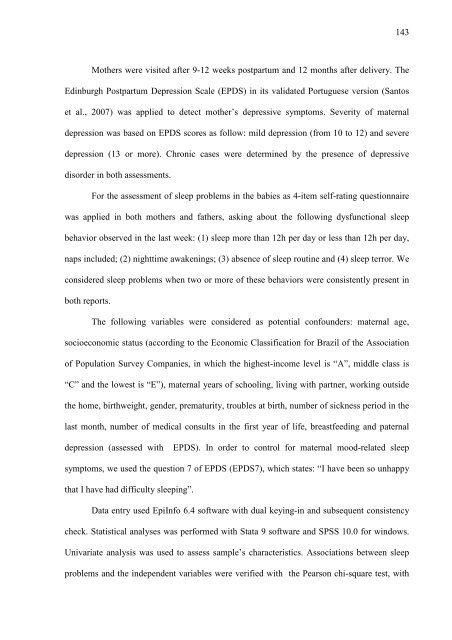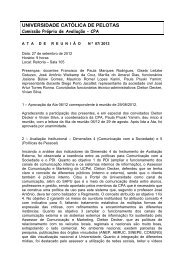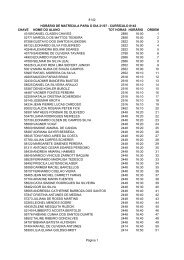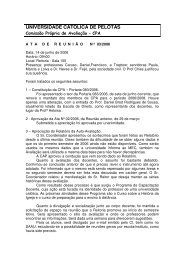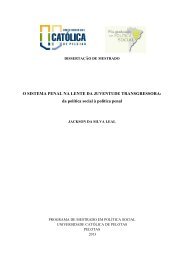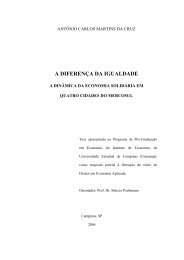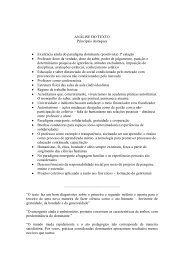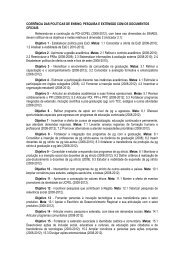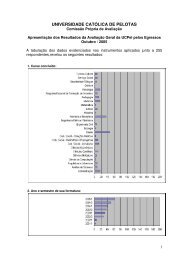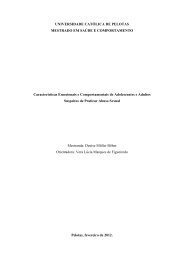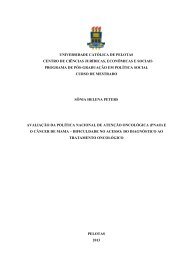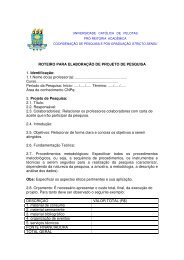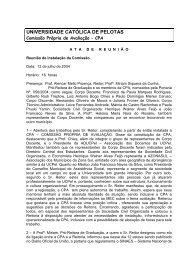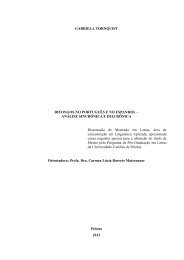Karen Amaral Tavares Pinheiro - Universidade Católica de Pelotas
Karen Amaral Tavares Pinheiro - Universidade Católica de Pelotas
Karen Amaral Tavares Pinheiro - Universidade Católica de Pelotas
Create successful ePaper yourself
Turn your PDF publications into a flip-book with our unique Google optimized e-Paper software.
143<br />
Mothers were visited after 9-12 weeks postpartum and 12 months after <strong>de</strong>livery. The<br />
Edinburgh Postpartum Depression Scale (EPDS) in its validated Portuguese version (Santos<br />
et al., 2007) was applied to <strong>de</strong>tect mother’s <strong>de</strong>pressive symptoms. Severity of maternal<br />
<strong>de</strong>pression was based on EPDS scores as follow: mild <strong>de</strong>pression (from 10 to 12) and severe<br />
<strong>de</strong>pression (13 or more). Chronic cases were <strong>de</strong>termined by the presence of <strong>de</strong>pressive<br />
disor<strong>de</strong>r in both assessments.<br />
For the assessment of sleep problems in the babies as 4-item self-rating questionnaire<br />
was applied in both mothers and fathers, asking about the following dysfunctional sleep<br />
behavior observed in the last week: (1) sleep more than 12h per day or less than 12h per day,<br />
naps inclu<strong>de</strong>d; (2) nighttime awakenings; (3) absence of sleep routine and (4) sleep terror. We<br />
consi<strong>de</strong>red sleep problems when two or more of these behaviors were consistently present in<br />
both reports.<br />
The following variables were consi<strong>de</strong>red as potential confoun<strong>de</strong>rs: maternal age,<br />
socioeconomic status (according to the Economic Classification for Brazil of the Association<br />
of Population Survey Companies, in which the highest-income level is “A”, middle class is<br />
“C” and the lowest is “E”), maternal years of schooling, living with partner, working outsi<strong>de</strong><br />
the home, birthweight, gen<strong>de</strong>r, prematurity, troubles at birth, number of sickness period in the<br />
last month, number of medical consults in the first year of life, breastfeeding and paternal<br />
<strong>de</strong>pression (assessed with<br />
EPDS). In or<strong>de</strong>r to control for maternal mood-related sleep<br />
symptoms, we used the question 7 of EPDS (EPDS7), which states: “I have been so unhappy<br />
that I have had difficulty sleeping”.<br />
Data entry used EpiInfo 6.4 software with dual keying-in and subsequent consistency<br />
check. Statistical analyses was performed with Stata 9 software and SPSS 10.0 for windows.<br />
Univariate analysis was used to assess sample’s characteristics. Associations between sleep<br />
problems and the in<strong>de</strong>pen<strong>de</strong>nt variables were verified with the Pearson chi-square test, with


